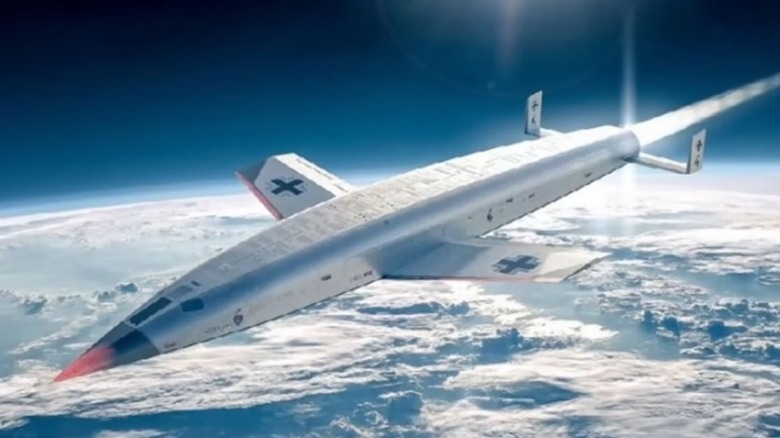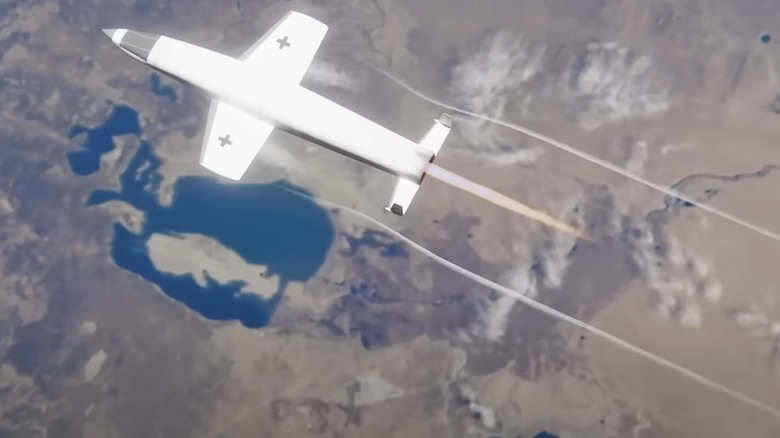This Nazi Aircraft Designed For Bombing New York Was Also A Space Shuttle
During World War II, the Nazis were incredibly adept at creating uber-secret weapons. Some worked, others didn't. Thankfully, a few never got off the design page and into the final creation stage. If they had, we might all live in an alternate world. The "Silbervogel" (German for "silver bird") is precisely one of those weapons.
Germany's then-Air Force chief Hermann Goering said that his military didn't have a bomber capable of dropping 4.5 tons of bombs on New York, a move that "would at last stuff the mouth of arrogance across the sea." By 1942 the Nazis still didn't have the technology and ordered the German Ministry of Aviation to work on the "Amerika Bomber" program for the Luftwaffe.
The goal was to build a "suborbital rocketship" that could make it over the Atlantic Ocean, drop bombs on a target anywhere in the United States, and return home intact to be used again. Austrian aeronautical engineer Eugen Sänger and mathematician Irene Bredt submitted their proposal for the Silver Bird.
Skipping across the atmosphere
Sänger and Bredt theorized that their if their plane could get into suborbital space it could glide back down, enter the Earth's atmosphere at just the right angle and basically skip along the surface indefinitely, much like a flat rock does over water. Thus, it could conceivably reach New York, drop its bombs, and return to Germany as Goering requested.
The Silver Bird would weigh some 100 tons, nearly all of it (90 tons) allotted for fuel, while five tons was designated for life support and four for its bomb payload, according to Jalopnik. Each bomb could be controlled by remote television with the hope that it would come within 400 miles of its intended target.
Since the front would bear the brunt of the pressure and heat during the multiple re-entries, a window wasn't practical. Instead, it would be equipped with a periscope type television system so the lone pilot could see where he was going, and with simple flight controls steer the plane accordingly. The pressurized cabin would hold one pilot, and have enough storage for food and water. It would also be surrounded by cooling tubes to keep the heat at bay as it bounced across the atmosphere.
This Nazi bird would have dropped nuclear devastation
The plan was for the Sliver Bird to take off o an almost two mile rail sled powered by a rocket that would get the plane going 1,200 miles per hour and lift into the air. Once airborne, it would fire its own rocket engines and climb up to an altitude of 90 miles (450,000 feet) going roughly 13,500 mph. The space plane would also be equipped with landing gear and wheels so it theoretically could land in Japan controlled China where it would be gathered up by Nazi henchmen, shipped back to the Motherland and reused as often as needed.
Keep in mind, most of this technology didn't exist in the mid 1940s. Including the nuclear bombs Goering so desperately wanted to drop on New York City. Thankfully, the war ended before the Silver Bird could be made.
But, would it have even worked? Probably not. According to Found and Explained, a post war analysis done on Sänger and Bredt's heat calculations uncovered a fatal flaw that proves the plane would have burned up and disintegrated when it attempted its first bounce. However, according to NBC, their theories and designs for the Silver Bird would go on to be used by both the Navy's Bureau of Aeronautics and NASA's predecessor, the National Advisory Committee for Aeronautics (NACA).

